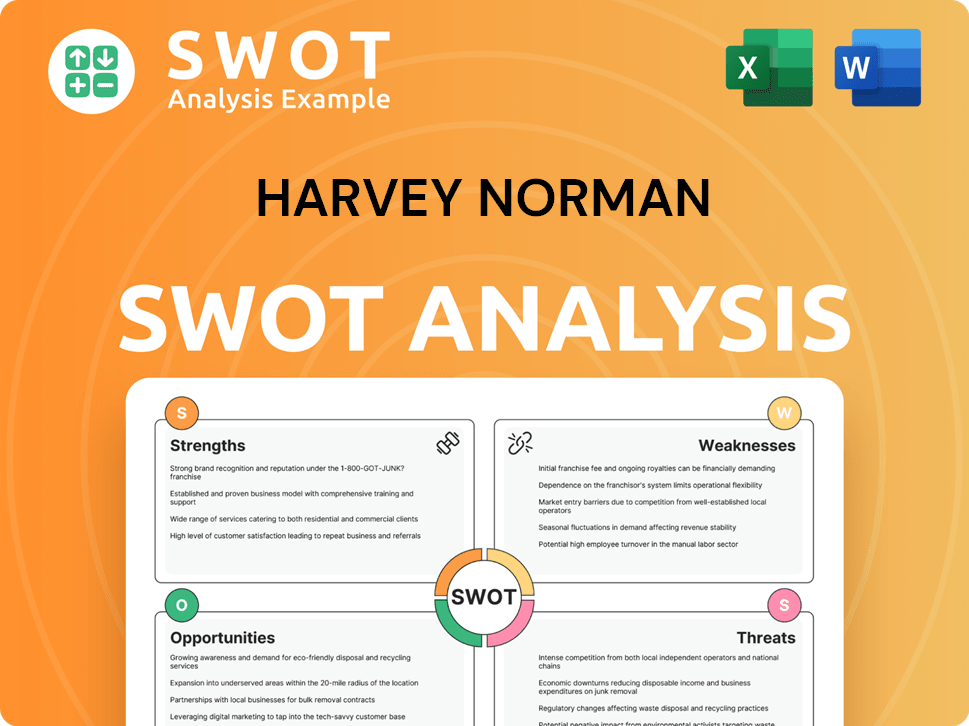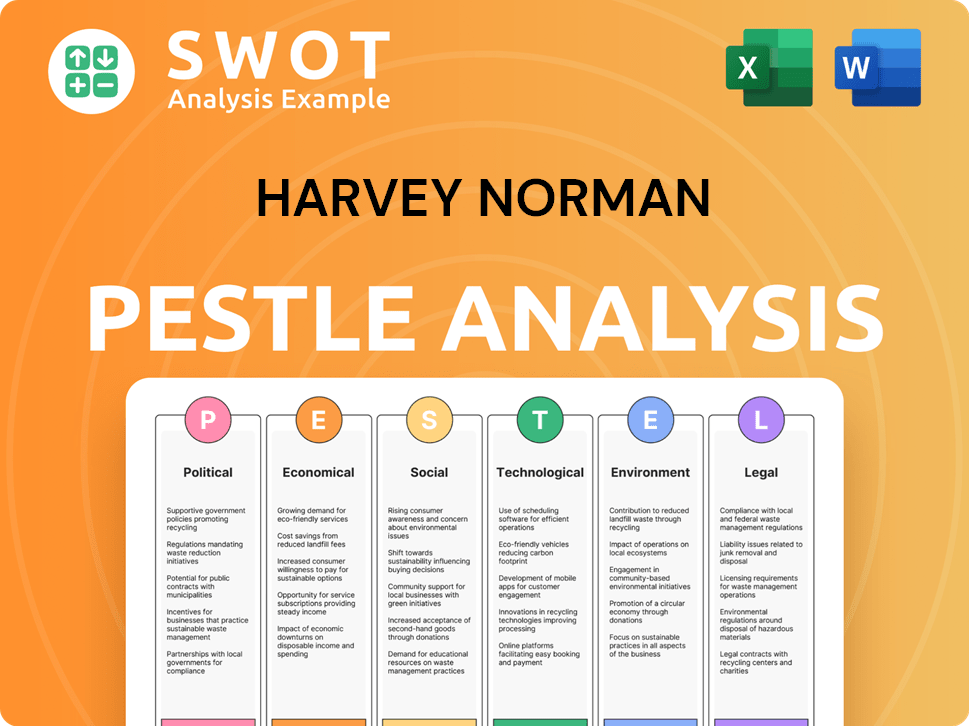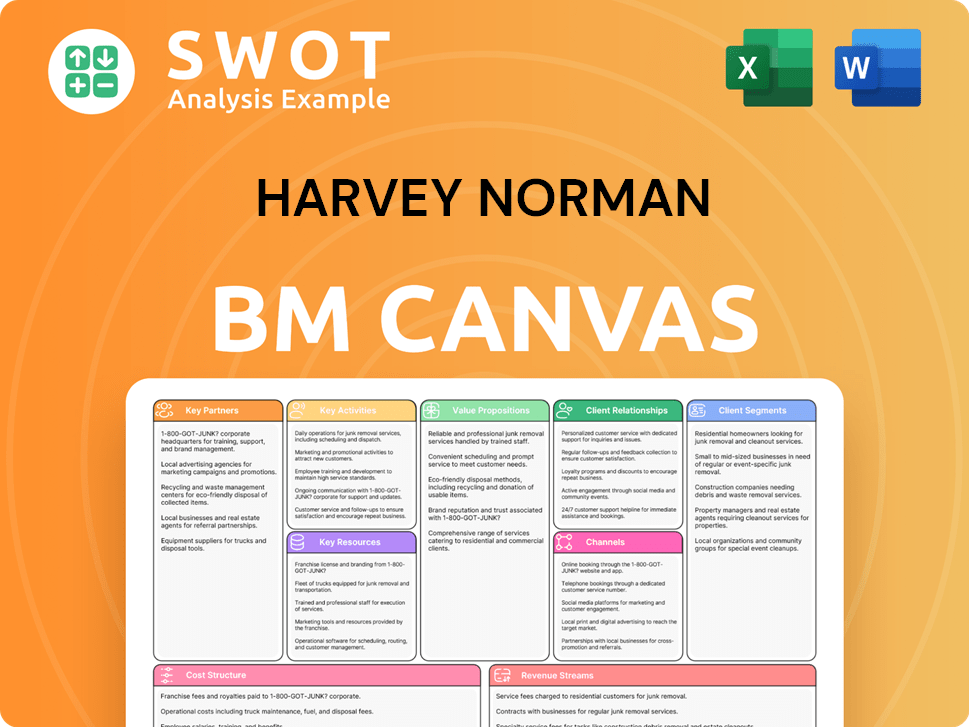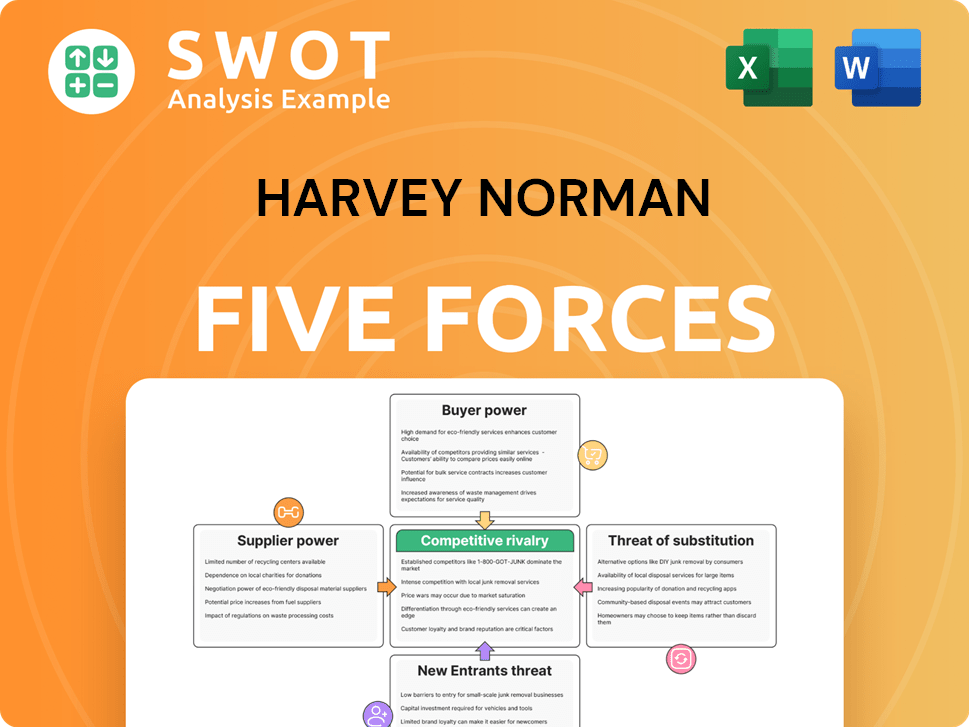Harvey Norman Bundle
How Does Harvey Norman Dominate the Retail Landscape?
Harvey Norman, a retail giant, has consistently adapted its Harvey Norman SWOT Analysis to stay ahead in the competitive consumer electronics market and home goods sector. Its success story is built on a foundation of smart sales and marketing strategies, blending physical and digital retail experiences. This approach has allowed it to effectively target customers and maintain a strong market presence.

This analysis dives deep into Harvey Norman's sales and marketing strategies, examining its evolution from a traditional retailer to an omnichannel powerhouse. Explore how Harvey Norman's business model leverages its physical stores and online platforms to drive sales performance. We'll uncover the secrets behind its advertising methods, promotional strategies, and digital marketing strategy, offering insights into its ability to capture and retain customer loyalty.
How Does Harvey Norman Reach Its Customers?
The sales channels of Harvey Norman are a key component of its Growth Strategy of Harvey Norman, utilizing a multi-faceted approach to reach its diverse customer base. This strategy primarily hinges on a blend of physical retail locations and e-commerce platforms. The company's approach is designed to provide customers with multiple touchpoints, creating a seamless shopping experience whether they prefer to browse in-store or online.
The company's strategy has evolved, with a significant shift toward digital adoption and omnichannel integration. This evolution reflects the changing consumer behavior and the increasing importance of e-commerce. The company actively supports its franchisees in implementing an online-to-offline (O2O) strategy to meet customer expectations. This approach allows customers to move flexibly between online browsing and in-store interaction, including services like 'Click and Collect'.
Key partnerships and exclusive distribution deals also contribute to Harvey Norman's growth and market share. These collaborations can lead to co-branded marketing campaigns and additional revenue streams. The company's property portfolio, valued at approximately AUD 4.23 billion as of August 2024, also underpins its retail network, providing a steady income stream from market-based rents and attracting additional customers through a mix of tenants.
Harvey Norman operates an extensive network of physical retail stores under the Harvey Norman, Domayne, and Joyce Mayne brands. As of November 2024, the company has 198 franchised complexes and 120 company-operated stores across eight countries. These large-format stores are designed to provide an immersive shopping experience.
Harvey Norman has an extensive online store, enabling customers to research, compare, and purchase products from home. Online sales contribute to revenue and serve as a marketing tool. The company has recognized the increasing importance of e-commerce, particularly accelerated by behavioral changes following the pandemic.
The company is actively assisting its Australian franchisees in implementing an online-to-offline (O2O) strategy to meet customer expectations. This omnichannel approach aims to provide a seamless customer journey, allowing flexibility between online browsing and in-store interaction, and includes services like 'Click and Collect'.
Harvey Norman maintains strong relationships with various suppliers and manufacturers, enabling it to offer a wide range of high-quality products. These collaborations can lead to co-branded marketing campaigns and additional revenue streams. The company has partnered with Tinybeans, an Australian marketing platform, to broaden its reach.
The company's sales and marketing strategy revolves around a multi-channel approach, combining physical stores, e-commerce, and strategic partnerships. This strategy aims to cater to diverse customer preferences and leverage market opportunities. The company's approach includes a focus on providing a seamless customer experience across all channels.
- Physical Retail: Large-format stores offering an immersive shopping experience.
- E-commerce: Online store for convenient shopping and research.
- Omnichannel Integration: Seamless transition between online and in-store experiences.
- Strategic Partnerships: Collaborations to expand reach and offer exclusive products.
Harvey Norman SWOT Analysis
- Complete SWOT Breakdown
- Fully Customizable
- Editable in Excel & Word
- Professional Formatting
- Investor-Ready Format

What Marketing Tactics Does Harvey Norman Use?
The company's sales and marketing strategy is a multifaceted approach, designed to boost brand awareness and drive sales across both digital and traditional channels. This strategy involves a blend of digital marketing initiatives, promotional events, and customer relationship management to engage a diverse customer base effectively. The company's focus on adapting to evolving consumer behaviors, particularly in the online retail space, is evident in its investments in technology and data-driven marketing.
The company actively uses a mix of digital and traditional media to reach a broad audience. This includes content marketing, e-commerce enhancements, and leveraging technology like AI and AR to personalize the shopping experience. Promotional events and seasonal sales are heavily advertised, driving significant traffic both online and offline. These promotions often feature discounts and special offers, attracting price-sensitive consumers.
The company's approach to data-driven marketing, customer segmentation, and personalization is evident in its efforts to understand and cater to its diverse customer base. It segments markets demographically by age and income, as well as psychographically based on consumer preferences and lifestyle. This allows them to tailor product offerings and marketing messages more effectively.
The company is increasingly focusing on digital channels to enhance its online presence and customer engagement. This includes content marketing, e-commerce improvements, and the use of AI to assist franchisees and company-operated stores. The company is experimenting with AR apps to personalize online purchases, demonstrating its commitment to adapting to online retail trends.
Traditional media continues to play a role in the company's marketing mix, although specific details on recent extensive TV, radio, or print campaigns in 2024-2025 are not readily available. Promotional events and seasonal sales are heavily advertised through these channels. These promotions often align with holidays and special occasions, offering discounts to attract consumers.
The company employs data-driven marketing techniques to understand and cater to its diverse customer base. This includes segmenting consumer markets demographically and psychographically. The company utilizes a CRM program, including loyalty programs, to build customer loyalty and trust. The company's focus on real-time analytics within its supply chain suggests the use of sophisticated systems.
The company segments its consumer markets demographically by age (e.g., Baby Boomers, Gen X, Millennials, Gen Z) and income groups, as well as psychographically based on consumer preferences and lifestyle. This segmentation allows them to tailor product offerings and marketing messages more effectively. This approach helps in targeting specific customer groups with relevant promotions.
The company utilizes customer relationship management (CRM) programs, including loyalty programs like the 'Harvey Norman Card,' which reward individual retail customers and business clients for purchases. These programs aim to build customer loyalty and trust. These programs help in retaining customers and encouraging repeat purchases.
The marketing mix has evolved to prioritize an omnichannel approach, combining the convenience of online shopping with the experiential benefits of physical stores, a notable innovation in its strategy. This strategy ensures that customers can interact with the company across multiple touchpoints.
The company's sales and marketing strategy is designed to capture and retain customers in the competitive consumer electronics market. Its focus on an omnichannel approach, combining online and physical retail, is a key element. For more insights, explore the Target Market of Harvey Norman.
The company's marketing tactics involve a blend of digital and traditional methods, coupled with data-driven strategies to enhance customer engagement and drive sales. These tactics are designed to reach a broad audience while also catering to specific customer segments. The company leverages promotional events and seasonal sales to boost traffic and revenue.
- Digital Marketing: Focus on content marketing, e-commerce enhancements, and AI integration.
- Traditional Media: Utilization of TV, radio, and print for broad reach, especially during promotional periods.
- Customer Segmentation: Targeting specific demographics and psychographics to tailor marketing messages.
- Loyalty Programs: Implementing CRM programs to build customer loyalty.
- Omnichannel Strategy: Integrating online and physical retail experiences.
Harvey Norman PESTLE Analysis
- Covers All 6 PESTLE Categories
- No Research Needed – Save Hours of Work
- Built by Experts, Trusted by Consultants
- Instant Download, Ready to Use
- 100% Editable, Fully Customizable

How Is Harvey Norman Positioned in the Market?
The brand positioning of Harvey Norman centers around being a trusted and established retailer. It offers a wide array of quality products, coupled with exceptional customer service. This approach differentiates it within the competitive consumer electronics market and broader retail landscape.
Their core message emphasizes being a one-stop shopping destination. This includes furniture, bedding, computers, communications, consumer electronics, and electrical appliances. This diverse product range allows them to cater to various customer preferences, which enhances their market share.
The visual identity and tone of voice are typically professional and supportive. The aim is to create an enjoyable shopping experience. This approach helps foster customer loyalty and brand recognition within the retail marketing sector.
Harvey Norman positions itself as a comprehensive retail solution. This includes a wide range of products for home and lifestyle needs. This allows customers to find everything they need in one place, enhancing convenience.
The company emphasizes product expertise and personalized assistance. Staff are trained to be knowledgeable about the extensive product range. This focus on customer service aims to build long-term relationships and enhance satisfaction, which is a key part of their sales and marketing approach.
Harvey Norman appeals to cost-conscious consumers by offering competitive pricing and frequent promotions. The company has increasingly focused on a low pricing strategy to attract a wider, price-sensitive customer base. This is a key element of their Growth Strategy of Harvey Norman.
Brand consistency is maintained across physical stores and digital touchpoints. This integrated approach ensures a seamless customer experience. This is a key element of their digital marketing strategy.
Harvey Norman responds to shifts in consumer sentiment by continually adapting its offerings. They are investing in digital transformation, such as exploring AI-driven smart appliances. While specific brand perception data or recent awards from 2024-2025 are not widely published, the company's sustained market presence and ongoing global expansion efforts indicate a resilient brand image. Their focus on innovation is crucial in the fast-paced consumer electronics market.
Harvey Norman Business Model Canvas
- Complete 9-Block Business Model Canvas
- Effortlessly Communicate Your Business Strategy
- Investor-Ready BMC Format
- 100% Editable and Customizable
- Clear and Structured Layout

What Are Harvey Norman’s Most Notable Campaigns?
The sales and marketing strategies of Harvey Norman are heavily influenced by seasonal events, product launches, and the integration of its omnichannel approach. These strategies aim to boost sales by leveraging various promotional activities and adapting to evolving consumer behaviors. Understanding the core components of their campaigns helps in analyzing the Harvey Norman sales strategy and its effectiveness in the competitive consumer electronics market.
A key aspect of Harvey Norman's approach involves utilizing major holidays and events to drive sales. Promotions such as discounts and special offers during events like '11.11,' Hari Raya, and Chinese New Year are common. Furthermore, the company's emphasis on its omnichannel model, which blends physical stores and online services, is a continuous marketing effort. This highlights Harvey Norman's marketing strategy to provide a seamless customer experience.
In addition to these strategies, Harvey Norman is focused on promoting its omnichannel model, which integrates physical stores with online services. This approach provides a seamless customer experience and is a core element of their marketing efforts. The company also focuses on promoting new products and technological advancements to maintain its market position. For instance, the company has shown interest in the 'Gen-AI product cycle' and is committed to investing in digital initiatives to promote Gen-AI enabled products to mainstream consumers.
Harvey Norman frequently runs sales during major holidays and events like '11.11', Hari Raya, and Chinese New Year. These promotions often include discounts, coupons, and vouchers to attract customers. The aim is to offer competitive pricing and boost sales during these periods.
A core aspect of Harvey Norman's strategy is the promotion of its omnichannel model. This approach integrates physical stores and online services to provide a seamless customer experience. The focus is on the convenience of browsing online and experiencing products in-store, along with 'Click and Collect' services.
Harvey Norman is keen on the 'Gen-AI product cycle' and invests in digital initiatives to promote Gen-AI enabled products. This indicates a forward-looking campaign focus on emerging technologies. The company aims to stay ahead by embracing new technological advancements.
Collaborations with partners, such as Tinybeans, are part of Harvey Norman's strategy to broaden audience engagement. This may involve influencer marketing or partnership marketing approaches to target specific segments. These collaborations help expand the brand's reach.
Harvey Norman's approach to sales and marketing is dynamic, adapting to market trends and consumer preferences. The company's ability to integrate online and offline experiences and embrace new technologies helps it maintain a competitive edge. To understand the company's evolution, it is helpful to review a Brief History of Harvey Norman.
Harvey Norman Porter's Five Forces Analysis
- Covers All 5 Competitive Forces in Detail
- Structured for Consultants, Students, and Founders
- 100% Editable in Microsoft Word & Excel
- Instant Digital Download – Use Immediately
- Compatible with Mac & PC – Fully Unlocked

Related Blogs
- What are Mission Vision & Core Values of Harvey Norman Company?
- What is Competitive Landscape of Harvey Norman Company?
- What is Growth Strategy and Future Prospects of Harvey Norman Company?
- How Does Harvey Norman Company Work?
- What is Brief History of Harvey Norman Company?
- Who Owns Harvey Norman Company?
- What is Customer Demographics and Target Market of Harvey Norman Company?
Disclaimer
All information, articles, and product details provided on this website are for general informational and educational purposes only. We do not claim any ownership over, nor do we intend to infringe upon, any trademarks, copyrights, logos, brand names, or other intellectual property mentioned or depicted on this site. Such intellectual property remains the property of its respective owners, and any references here are made solely for identification or informational purposes, without implying any affiliation, endorsement, or partnership.
We make no representations or warranties, express or implied, regarding the accuracy, completeness, or suitability of any content or products presented. Nothing on this website should be construed as legal, tax, investment, financial, medical, or other professional advice. In addition, no part of this site—including articles or product references—constitutes a solicitation, recommendation, endorsement, advertisement, or offer to buy or sell any securities, franchises, or other financial instruments, particularly in jurisdictions where such activity would be unlawful.
All content is of a general nature and may not address the specific circumstances of any individual or entity. It is not a substitute for professional advice or services. Any actions you take based on the information provided here are strictly at your own risk. You accept full responsibility for any decisions or outcomes arising from your use of this website and agree to release us from any liability in connection with your use of, or reliance upon, the content or products found herein.